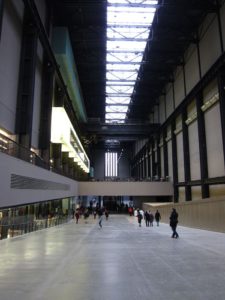I’m a sucker for great museums, there are few better ways to kill an afternoon. I have some favorites, both esoteric and mainstream. The Design Museum and National Portrait Gallery in London, Musée d’Orsay in Paris, Udvar-Hazy Center in Washington, the awesome Leonardo da Vinci Museum in Milan and so on.
Clearly it’s not a short list and this week it got a little longer when the Getty Center got added.
A great museum is more than just what’s inside, the setting should enhance the collection. My favorite example is the Tate modern, enter by walking down the ramp into what used to be the turbine hall of the Bankside power station. This is reuse on a huge scale and the industrial setting complements the collection perfectly.


7 Comments
Yes, I loved the Musee d’Orcay as well. One of my fave museums is the Russian Museum in Saint Petersburg. It’s better than the Hermitage in my opinion because it’s full of actual Russian masterpieces, and not the mostly Pan-Euro paintings of the Hermitage. Here’s the link: http://www.rusmuseum.ru/eng/home/
BTW, I’m over from A to Z. Pop on by if you like!
I love museums too!
The National Portrait Gallery was one of my favourite haunts in London when I was a student. I also loved the Natural History Museum in Bergamo, with its mammoth and baby mammoth at the entrance.
My favourites in Paris are the Gustav Moreau museum (near St Lazare) and the Orangeraie with Monet’s hypnotic nénuphars.
I’m also translating a book about museums – and how different museums present the same event. I’ve done 3 chapters: war museums in Japan, slave trade museums in Liverpool, Nantes and Bordeaux, and the Belgian section of the Auschwitz museum. It’s fascinating (and makes a real change from the stuff I usually translate, which is generally either medical or technical).
Oh, one last museum I’d recommend: Galatea, the Museum of the Sea in Genoa, Italy. Amazing.
I was in the Yūshūkan museum in Tokyo a little over a year ago. It’s a fascinating place, I really don’t know what other word to use for it.
There is a significant installation about the Japanese occupation of Manchuria in the 30’s. However the “Nanjing Incident” is mentioned only once in passing. The rest of the world knows it as the Nanjing Massacre and the museum does not even dismiss the events, it chooses to largely ignore them.
The same revisionism is evident with the reasons given in the museum for the start of the Second World War. Blame is squarely put on the US and Great Britain for forcing Japan into the war by putting in place a series of sanctions that (according to the museum) forced Japan into the war it wanted no part of.
As I said it’s an interesting place.
Thank you for more museums to add to my list.
The museum in Cairo is awesome with the ancient egyptian treasures, but the one I like best is the British Museum. I’ve used it in many of my books.
http://francene-wordstitcher.blogspot.com
Yes, the British Museum, another one of my must see favorites when I’m visiting my family.
The Great Court is a terrific space and the Elgin Marbles can keep me occupied for a morning. Great call.
Dave
Stopping by from the Challenge. Hope you’ll visit back.
I’m with you on museums. I love them. I read all the captions; therefore I take a long time when I visit. I love the Museum of Natural Science in Houston. The most unusual museum I’ve seen is the Guggenheim in Spain.
Your comments about the Yushukan are exactly what the book I’m translating is talking about – a very specific approach to world events. The author’s thing is that Japanese museums are very focused on their status as victims, not so much on their status as invading massacring troops. Fascinating stuff. I’ll let you know the title and author (as I said, I’m getting the book in dribs and drabs, but each chapter is by someone different if the writing styles are anything to go by) when I know them.
I also forgot to mention the Guggenheim in Bilbao, which I see is on your list. Another amazing place, even my daughters (then aged only 8 and 6) really enjoyed it.